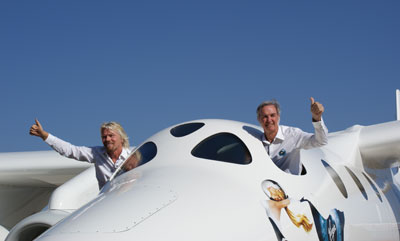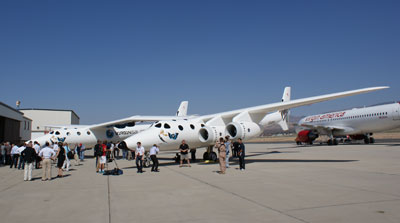A White Knight for more than personal spaceflightby Jeff Foust
|
| Rutan said flight tests of WhiteKnightTwo should be less risky than the original White Knight. “So even though this is a pretty weird airplane, we all expect it to fly very well.” |
Nonetheless, WhiteKnightTwo is still a stunning aircraft. The unusual twin-fuselage design, connected by a wing over 40 meters long, has enough room in the middle for SS2, allowing it to connect directly to the wing rather than suspend it under the fuselage, as was the case for SS1 and the original White Knight aircraft. The pilots will fly the aircraft from the right-side fuselage, with room for passengers, such as people training for their own suborbital flights, in both fuselages.
This WK2, named Virgin Mother Ship (VMS) Eve, after Sir Richard Branson’s mother, has yet to fly, but will start flight tests by the fall. “The program on this will be very similar to any other research and development aircraft,” Burt Rutan said. “As we do flight tests, we can then have more confidence in what our product is, more confidence in what our schedule will be.”
Rutan said that there’s an old industry maxim that you learn 80 percent of what you will ever find out on an airplane on its first flight. “That’s not really true, but the success of the plane’s flying qualities tells you a lot about whether you’ll have to do a lot more flight testing or whether you can march through opening up the envelope very quickly.”
“We expect this airplane to fly well,” he added. “We know that we have risks, that there will need to be tweaks and modifications for it to fly optimally. The program will involve operating initially with a relatively small envelope, but very soon in the program it will be up to very, very high altitudes, and later in the program we will be opening up to higher speeds and higher g-levels.”
Rutan said that the risks were a lot higher on the original White Knight, which was the first plane Scaled built with a twin-boom configuration, yet it flew quite well. “So even though this is a pretty weird airplane, we all expect it to fly very well.”
Still, both Virgin and Scaled made it clear that VMS Eve was a prototype, although one that should eventually be an operational aircraft as well. “There are always things that you bookkeep as ‘this is how we’d do it the next time around,’” said Bob Morgan, the lead engineer for WK2 at Scaled. “We’ve created quite a laundry list for the production vehicle. A lot of times it’s done to facilitate cost and schedule and isn’t required to demonstrate performance of the airplane or to meet mission goals.”
“So far, this plane is looking so good we should be able to put it into service eventually, as well as using it for the test program,” said Virgin Galactic president Will Whitehorn.
| “We also hope that, in the future, this vehicle will be developed and certified for conventional payload work within the atmosphere, but that will be another story for another day,” said Whitehorn. |
As for what kind of service WK2 will be put into, Whitehorn emphasized that the aircraft can be used as more of a launching platform for SS2. “We set Burt a challenge: the challenge of trying to design a system coming out of SpaceShipOne, of producing a launch system for us that could allow thousands of people to fulfill their dream” of traveling into space, Whitehorn said. “But we also quietly asked Burt to do something else. Our vision of WhiteKnightTwo, and his, was of a launch system that could be part of a longer-term development program… a WhiteKnightTwo with an open architecture which would allow other people to develop other vehicles capable of doing other things.”
Among those applications would be as a platform for expendable or even reusable boosters for launching small satellites, in much the same way Orbital Sciences Corporation’s Pegasus rocket is air-launched from an L-1011 aircraft. Whitehorn also suggested that WK2 could become a high-altitude aircraft for research and other terrestrial applications: “We also hope that, in the future, this vehicle will be developed and certified for conventional payload work within the atmosphere, but that will be another story for another day.” WK2’s status as the largest all-composite aircraft, Virgin officials believe, could also help drive development in aviation of other composite aircraft that could offer greater fuel efficiency.
 Sir Richard Branson (left) and Burt Rutan give the thumbs-up from the cockpit of WhiteKnightTwo. (credit: J. Foust) |
The status of SpaceShipTwo
But what about what is WhiteKnightTwo’s primary mission, as a launch platform for SS2? During the unveiling event in Mojave, and in a short question-and-answer session that followed, virtually nothing was said about the status of the suborbital vehicle, whose development has been subject to questions and speculation since a “cold flow” propulsion system test just over a year ago killed three Scaled employees. The lack of discussion about SS2 was ironic because the vehicle was literally in the hangar, off to one side and shrouded in black.
In a brief interview after the unveiling ceremony, Rutan said that the investigation into the July 2007 accident was complete and the report about it would be released “soon”. “With our new owner [Northrop Grumman] and with the constraints we’re under it’s difficult to get things released, but we’re in the process of doing that,” he said.
Rutan confirmed that the investigation was causing “a lot” of design changes for SS2. “We have not worked on SpaceShipTwo in a year,” he said, “because there’s a possibility that the propulsion system would be markedly different and we’d be building things that we would have to scrap.” He declined to comment on whether, in fact, SS2 will have a different propulsion system than originally planned, saying that details about any changes would be announced “in a different venue.”
On Friday, four days after the unveiling event, Scaled did release an “Accident Investigation Update”. According to the update, an investigation by state safety regulators Cal OSHA failed to determine the cause of the explosion. The update did outline a number of changes Scaled was making, most of which involve the handling and use of nitrous oxide, suggesting that the company was staying with the same general hybrid propulsion concept it previously planned for the vehicle.
As in the past, Virgin officials said they put a premium on safety, and would have that drive their schedule. “Government spaceflight does not have a reputation for safety after 50 years,” Whitehorn said. “If we can create a reputation for safety in the private, commercial sector, and regularize spaceflight, it will be the most important single signal one can send to allow a much greater level of investment in private sector space in the future.”
| “We have not worked on SpaceShipTwo in a year,” Rutan said, “because there’s a possibility that the propulsion system would be markedly different and we’d be building things that we would have to scrap.” |
Of course, things don’t always go as planned, which may be why there’s a greater emphasis on additional applications that could use WK2 than just suborbital personal spaceflight. But then, the same can be said for conventional aviation as well. While flying people to and from Mojave appeared to be a faster solution than driving—they planned a 20-minute flight time between LAX and Mojave Air and Space Port—practice turned out to be a little more unforgiving than theory. A late boarding of the aircraft, along with air traffic control problems at LAX, meant that the plane returned to LA at around 1 pm, rather than the 10:30 am originally planned. In that case, it would certainly have been faster to drive than to fly. But sometimes schedule is not the only, or most important, factor.
